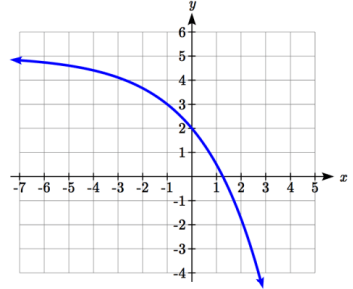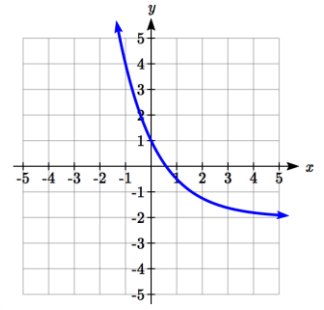FIND THE EQUATION OF A TRANSFORMED EXPONENTIAL FUNCTION FROM A GRAPH
Subscribe to our ▶️ YouTube channel 🔴 for the latest videos, updates, and tips.
Any transformed exponential can be written in the form
y = abx - h + k
where y = k is the horizontal asymptote.
Note that, due to the shift, the vertical intercept is shifted to (0, a+k)
Find the exponential function represented by the graph given below.
Problem 1 :

Solution :
y = abx + k
Here, the Horizontal asymptote is y = -1. So, k = -1
y = abx - 1 ------(1)
Tracing two points from the graph of the given function given above.
(0, 2) and (-5, -1)
Applying the point (0, 2) in (1), we get
2 = ab0 - 1
2 = a(1) - 1
a = 2 + 1
a = 3
Applying the point (1, 5) in (1), we get
5 = ab1 - 1
6 = 3(b1)
b = 6/3
b = 2
So, the required exponential function is
y = 3(2)x - 1
Problem 2 :

Solution :
y = abx + k
Here, the Horizontal asymptote is y = 5. So, k = 5
y = abx + 5 ------(1)
Tracing two points from the graph of the given function given above.
(0, 2) and (-1, 3)
Applying the point (0, 2) in (1), we get
2 = ab0 + 5
2 - 5 = a(1)
a = -3
Applying the point (-1, 3) in (1), we get
3 = (-3)b-1 + 5
3 - 5 = -3(1/b)
-2 = -3/b
b = 3/2
b = 1.5
So, the required exponential function is
y = -3(1.5)x + 5
Problem 3 :

Solution :
y = abx + k
Here, the Horizontal asymptote is y = 1. So, k = 1
y = abx + 1 ------(1)
Tracing two points from the graph of the given function given above.
(-2, 0) and (0, -3)
Applying the point (-2, 0) in (1), we get
0 = ab-2 + 1
-1 = a/b2
Applying the point (0, -3) in (1), we get
-3 = ab0 + 1
-3 - 1 = a(1)
a = -4
Applying the value of a, we get
-4/b2 = -1
b2 = 4
b = 2
So, the required exponential function is
y = -4(1.5)x + 5
Problem 4 :

Solution :
y = abx + k
Here, the Horizontal asymptote is y = 3. So, k = 3
y = abx + 3 ------(1)
Tracing two points from the graph of the given function given above.
(0, 2) and (1, 1)
Applying the point (0, 2) in (1), we get
2 = ab0 + 3
-1 = a(1)
a = -1
Applying the point (1, 1) in (1), we get
1 = (-1)b1 + 3
1 - 3 = -b
b = 2
So, the required exponential function is
y = -1(2)x + 3
Problem 5 :

Solution :
y = abx + k
Here, the Horizontal asymptote is y = 3. So, k = 3
y = abx + 3 ------(1)
Tracing two points from the graph of the given function given above.
(0, 1) and (-1, -1)
Applying the point (0, 1) in (1), we get
1 = ab0 + 3
-2 = a(1)
a = -2
Applying the point (-1, -1) in (1), we get
-1 = (-2)b-1 + 3
-4/(-2) = 1/b
b = 1/2
So, the required exponential function is
y = -2(1/2)x + 3
Problem 6 :

Solution :
y = abx + k
Here, the Horizontal asymptote is y = -2. So, k = -2
y = abx - 2------(1)
Tracing two points from the graph of the given function given above.
(0, 1) and (-1, 4)
Applying the point (0, 1) in (1), we get
1 = ab0 - 2
3 = a(1)
a = 3
Applying the point (-1, 4) in (1), we get
4 = (2)b-1 - 2
4 + 2 = 2/b
6b = 2
b = 1/3
So, the required exponential function is
y = 3(1/3)x - 2
Problem 7 :

Solution :
y = abx + k
Here, the Horizontal asymptote is y = 7. So, k = 7
y = abx + 7------(1)
Tracing two points from the graph of the given function given above.
(0, 5) and (1, 1)
Applying the point (0, 5) in (1), we get
5 = ab0 + 7
5 - 7 = a(1)
a = -2
Applying the point (1, 1) in (1), we get
1 = (-2)b1 + 7
-6 = -2b
b = 3
So, the required exponential function is
y = -2(3)x + 7
Problem 8 :

Solution :
y = abx + k
Here, the Horizontal asymptote is y = 5. So, k = 5
y = abx + 5------(1)
Tracing two points from the graph of the given function given above.
(0, 3) and (-1, -1)
Applying the point (0, 3) in (1), we get
3 = ab0 + 5
-2 = a(1)
a = -2
Applying the point (-1, -1) in (1), we get
-1 = (-2)b-1 + 5
-6 = -2/b
b = 1/3
So, the required exponential function is
y = -2(1/3)x + 5
Subscribe to our ▶️ YouTube channel 🔴 for the latest videos, updates, and tips.
Recent Articles
-
Finding Range of Values Inequality Problems
May 21, 24 08:51 PM
Finding Range of Values Inequality Problems -
Solving Two Step Inequality Word Problems
May 21, 24 08:51 AM
Solving Two Step Inequality Word Problems -
Exponential Function Context and Data Modeling
May 20, 24 10:45 PM
Exponential Function Context and Data Modeling